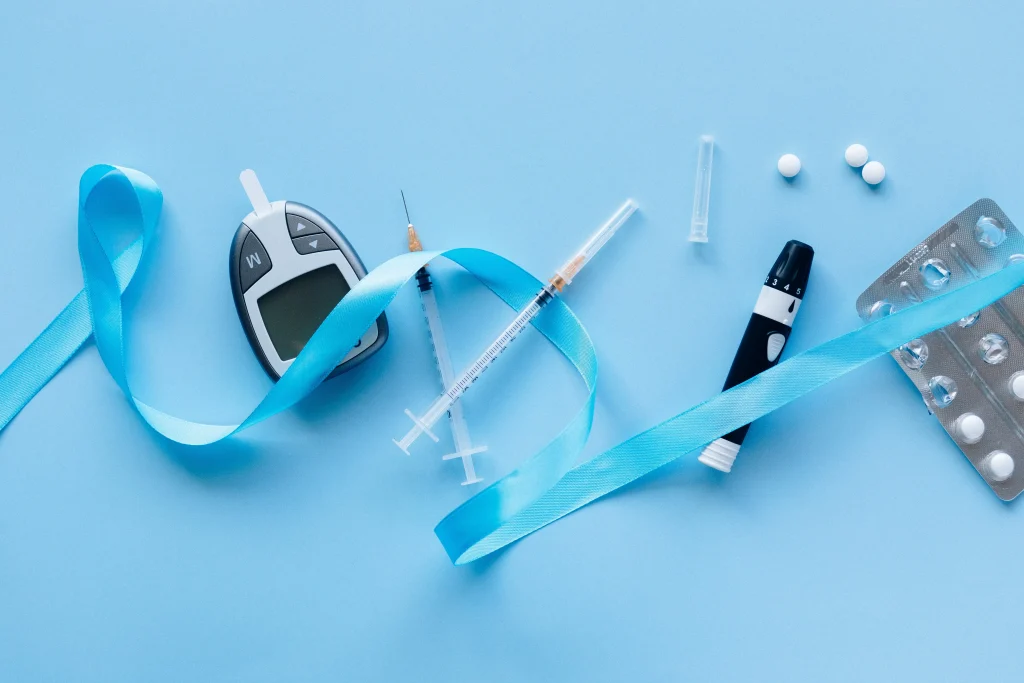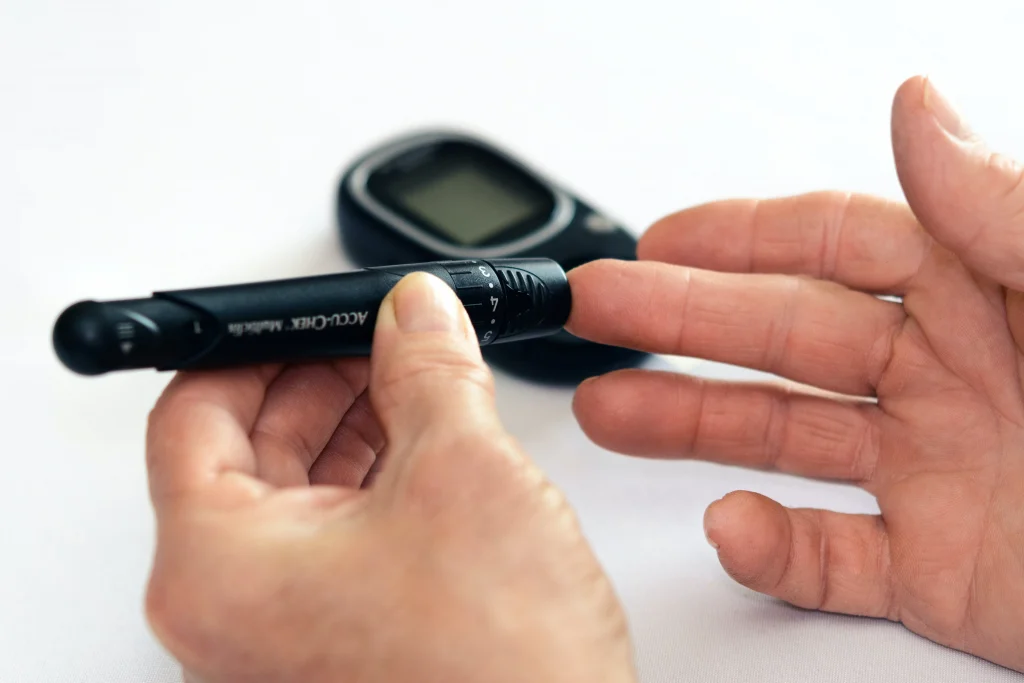Type 1 diabetes is a chronic health condition that affects the way the body processes glucose, the main source of energy for the body’s cells. In people with type 1 diabetes, the immune system attacks and destroys the cells in the pancreas that produce insulin, a hormone that regulates blood sugar levels. This means that people with type 1 diabetes must inject insulin or use an insulin pump to manage their blood sugar levels.
Type 1 diabetes usually develops in childhood or young adulthood, but it can occur at any age. Managing type 1 diabetes can be challenging, but with the right tools and support, people with this condition can live long and healthy lives. A healthy diet, regular exercise, and frequent monitoring of blood sugar levels are crucial components of successful diabetes management.
Symptoms of Type-1 Diabetes
Type 1 diabetes is a chronic health condition characterized by an inability to produce insulin, the hormone responsible for regulating blood sugar levels. People with type 1 diabetes must rely on insulin injections or an insulin pump to manage their blood sugar levels. Symptoms of type 1 diabetes often develop suddenly and can include:
Increased thirst
This is due to high blood sugar levels, which can cause dehydration. Increased thirst is a common symptom of type 1 diabetes. When glucose levels are too high in the blood, the body tries to get rid of the excess glucose through urination. This can lead to dehydration, which in turn can cause an increase in thirst. The body signals the person to drink more fluids to replace what is lost through frequent urination. If left untreated, dehydration can lead to more serious health problems.
Frequent urination
The body tries to get rid of excess glucose by producing more urine. Frequent urination is another common symptom of type 1 diabetes. This occurs because the body tries to get rid of the excess glucose in the blood through urine production. When there is too much glucose in the blood, the kidneys are unable to absorb it all, and it passes out of the body in the urine. This can lead to frequent trips to the bathroom and increased fluid loss, which can cause dehydration. If you are experiencing frequent urination, it is important to speak with a healthcare provider for proper evaluation and diagnosis.
Hunger
The body is not able to use glucose for energy, leading to feelings of hunger even after eating. This occurs because the body is not able to use glucose, the main source of energy, effectively. Despite eating, the body is not able to utilize glucose for energy, causing feelings of hunger. This is because the body is not producing enough insulin to regulate blood sugar levels, making it difficult for the body to use glucose for energy. If you are experiencing hunger despite eating, it is important to speak with a healthcare provider for proper evaluation and diagnosis.

Fatigue
High blood sugar levels can make a person feel tired and weak. High blood sugar levels can make a person feel tired and weak because the body is unable to use glucose for energy. Insulin is needed to convert glucose into energy that the body can use. In people with type 1 diabetes, the pancreas is not producing enough insulin, leading to high blood sugar levels and fatigue. Additionally, frequent urination can also cause dehydration, which can contribute to feelings of tiredness and weakness.
Blurred vision
High blood sugar levels can cause fluid to build up in the lens of the eye, leading to temporary blurred vision. Over time, if left untreated, high blood sugar levels can also damage blood vessels in the eyes, leading to more serious vision problems such as diabetic retinopathy.
Slow-healing cuts and wounds
High blood sugar levels can affect the body’s ability to heal, leading to slow wound healing. This can occur because high blood sugar levels can damage blood vessels, reducing blood flow to the affected area and slowing down the healing process. Additionally, people with type 1 diabetes may also be more prone to infections, which can further delay the healing of wounds.
Nausea and vomiting
Nausea and vomiting are not common symptoms of type 1 diabetes, but can occur in some cases. High blood sugar levels can cause nausea and vomiting in some people, especially if their blood sugar levels are very high or if they have developed ketoacidosis, a serious complication of type 1 diabetes. Ketoacidosis occurs when the body starts to break down fat for energy because it is not getting enough glucose, leading to the buildup of toxic chemicals called ketones in the blood.
It’s important to note that not everyone with type 1 diabetes will experience all of these symptoms, and symptoms can vary from person to person. If you are experiencing any of these symptoms, it’s important to see a doctor for a diagnosis. Early diagnosis and treatment of type 1 diabetes can help prevent serious health complications, such as heart disease, nerve damage, and kidney damage.
Treating Type 1 Diabetes
Treatment for type 1 diabetes involves managing blood sugar levels to prevent serious health problems and complications. The main components of treatment for type 1 diabetes include:
Insulin Therapy
Insulin therapy is the main treatment for type 1 diabetes. It is a hormone that helps the body use glucose (sugar) for energy. People with type 1 diabetes do not produce enough insulin, so they must take insulin injections or use an insulin pump to replace the missing insulin.
There are several types of insulin available, including rapid-acting, short-acting, intermediate-acting, and long-acting. The type and amount of insulin a person needs will depend on their individual needs, blood sugar levels, and lifestyle.
Insulin injections are given using a needle or an insulin pen. The injection site can be changed to different areas of the body to prevent skin irritation and to avoid building up too much insulin in one area.
An insulin pump is another option for insulin delivery. An insulin pump is a small device that is worn on the outside of the body and delivers insulin continuously through a thin tube (catheter) that is inserted just under the skin. The pump can be programmed to deliver insulin in response to changes in blood sugar levels.
It is important to work closely with a healthcare provider to develop an insulin therapy plan that is best for you. Insulin therapy is essential for managing blood sugar levels and preventing serious health problems and complications associated with type 1 diabetes.

Healthy Eating
Healthy eating is an important component of treatment for type 1 diabetes. Eating a balanced diet that is low in added sugars and high in fiber can help manage blood sugar levels by providing the body with the necessary nutrients to function properly while avoiding spikes in blood sugar levels. Meal planning and portion control can also be helpful in managing blood sugar levels.
Eating smaller, frequent meals and snacks can help keep blood sugar levels stable. Whole grain foods such as whole wheat bread, brown rice, and oatmeal are a better option than refined grains as they have a lower glycemic index, meaning they cause a slower and smaller rise in blood sugar levels.
Foods high in fiber, such as fruits, vegetables, and whole grains, can help regulate blood sugar levels. Items and drinks high in added sugars, such as candy, soda, and fruit juice, can cause spikes in blood sugar levels. Foods high in lean protein, such as chicken, fish, and tofu, can help regulate blood sugar levels and provide the body with essential nutrients.
Physical Activity
Physical activity is an important component of treatment for type 1 diabetes. Regular exercise can help regulate blood sugar levels, improve insulin sensitivity, and reduce the risk of developing serious health problems and complications associated with type 1 diabetes.
Aim to get at least 30 minutes of physical activity most days of the week. This can be achieved through moderate intensity activities such as walking, cycling, or swimming. Select activities that you enjoy, such as playing a sport, dancing, or taking a fitness class, to increase your chances of sticking to an exercise routine.
Mixing up your physical activity routine with different types of exercise can help prevent boredom and injury. Before, during, and after physical activity, it’s important to monitor your blood sugar levels and adjust your insulin doses if necessary.
Consult with your healthcare provider to determine what type and amount of physical activity is safe and appropriate for you. Physical activity, along with a healthy eating plan and insulin therapy, is essential for managing blood sugar levels and preventing serious health problems and complications associated with type 1 diabetes. Regular exercise can also help improve overall health and quality of life.
Monitoring Blood Sugar Levels
Monitoring blood sugar levels is an important component of treatment for type 1 diabetes. Regular monitoring can help you understand how different foods, physical activity, stress, and medications can affect your blood sugar levels and make adjustments to your treatment plan as needed.
A blood glucose meter is a small device that measures the amount of glucose (sugar) in a drop of blood. This device can be used to measure blood sugar levels at anytime, anywhere. Test your blood sugar levels regularly to get a better understanding of how your body is managing glucose. This can be done multiple times a day, before and after meals, and before and after physical activity.
Keeping a log of your blood sugar levels, insulin doses, and food intake can help you and your healthcare provider identify patterns and make necessary adjustments to your treatment plan. Regular monitoring allows you to identify trends in your blood sugar levels and make changes to your treatment plan to keep your levels within a healthy range.
Regular monitoring of blood sugar levels is crucial for managing type 1 diabetes and preventing serious health problems and complications.

Reasons of Type 1 Diabetes
There is no single cause of type 1 diabetes, but several factors that may contribute to the development of this condition include:
Genetics
Genetics play a role in the development of type 1 diabetes, and a family history of the condition is a risk factor for its development.
Studies have shown that type 1 diabetes has a heritability of up to 50-60%. This means that genetics plays a significant role in the development of this condition. There are specific genes that have been associated with an increased risk of developing type 1 diabetes. These genes are involved in the regulation of the immune system and insulin production.
HLA genes play a major role in the development of type 1 diabetes. These genes are involved in the immune response and can increase the risk of developing the condition if they are present in a certain combination. If a close relative, such as a parent or sibling, has type 1 diabetes, you are at an increased risk of developing the condition. This risk is highest if the relative was diagnosed at a young age.
Studies have shown that the risk of one twin developing type 1 diabetes is much higher if the other twin has the condition.
It’s important to note that genetics is only one factor that contributes to the development of type 1 diabetes, and not everyone with a family history of the condition will develop it. Other factors, such as environmental factors and lifestyle, can also play a role in the development of this condition. However, genetic testing may be useful for individuals with a strong family history of type 1 diabetes to assess their risk of developing the condition.
Environmental factors
Several environmental factors have been suggested to contribute to the development of type 1 diabetes. Some viruses have been linked to an increased risk of type 1 diabetes, including coxsackievirus, mumps virus, and rotavirus.
Exposure to certain toxins, such as pesticides, may increase the risk of type 1 diabetes.The timing and composition of a person’s diet may play a role in the development of type 1 diabetes. For example, early exposure to cow’s milk has been associated with an increased risk of type 1 diabetes.
The incidence of type 1 diabetes varies by geography, with higher rates seen in some regions compared to others. There is evidence to suggest that living at higher latitudes, where there is less sun exposure and a lower production of vitamin D, may increase the risk of type 1 diabetes.
It’s important to note that the specific environmental factors that contribute to the development of type 1 diabetes are not fully understood, and ongoing research is aimed at uncovering the causes of this condition. Additionally, not all people with exposure to these environmental factors will develop type 1 diabetes, and not everyone with type 1 diabetes will have been exposed to these factors. However, avoiding certain environmental risks, such as exposure to toxins, may be beneficial for reducing the risk of developing type 1 diabetes.
Age
The age at which a person is diagnosed with type 1 diabetes can vary, but the condition typically develops in childhood or adolescence. The age of onset can play a role in the development and progression of type 1 diabetes, and can also impact treatment decisions.
Children and adolescents who develop type 1 diabetes are at an increased risk of developing complications from the condition, such as diabetic ketoacidosis and nerve damage.
The earlier a person is diagnosed with type 1 diabetes, the longer they have to live with the condition and the greater their risk of developing complications over time. Adolescence can be a difficult time for people with type 1 diabetes, as they navigate the physical and emotional changes of this stage of life while managing a chronic condition.
As people with type 1 diabetes age, they may experience a decline in their ability to produce insulin, and may require additional treatment or adjustments to their current treatment plan. Older individuals with type 1 diabetes are at an increased risk of developing complications from the condition, such as cardiovascular disease and kidney disease.
It’s important to understand that type 1 diabetes can develop at any age, and the specific impact of age on the development and progression of the condition can vary for each individual.
Ethnicity
Studies have shown that the incidence and prevalence of type 1 diabetes can vary by ethnicity. However, it’s important to note that ethnicity is not a direct cause of type 1 diabetes. Rather, certain ethnic populations may have a higher genetic predisposition to the condition or may be exposed to certain environmental factors that increase the risk of developing type 1 diabetes.
Non-Hispanic whites are at a higher risk of developing type 1 diabetes compared to other ethnic groups. African Americans are less likely to develop type 1 diabetes compared to non-Hispanic whites, but may be at a higher risk of developing complications from the condition, such as cardiovascular disease and kidney disease.
The incidence of type 1 diabetes in the Hispanic population is relatively low compared to non-Hispanic whites, but may be increasing in some subgroups of this population. The incidence of type 1 diabetes in Asian populations is relatively low compared to non-Hispanic whites, but may vary among different subgroups of this population.
It’s important to understand that these general trends do not hold true for every individual, and the specific impact of ethnicity on the development and progression of type 1 diabetes.
Final Thoughts
Type 1 Diabetes is a chronic autoimmune disease that affects millions of people globally. It occurs when the body’s immune system attacks and destroys the cells in the pancreas responsible for insulin production. People with Type 1 Diabetes must manage their blood sugar levels through daily insulin injections or an insulin pump, a balanced diet, and regular physical activity. Advances in technology and treatment options have greatly improved the quality of life for those living with Type 1 Diabetes, but there is still a need for ongoing research to find a cure. It is crucial for individuals with Type 1 Diabetes to work closely with their healthcare team to effectively manage their condition and reduce the risk of potential complications.